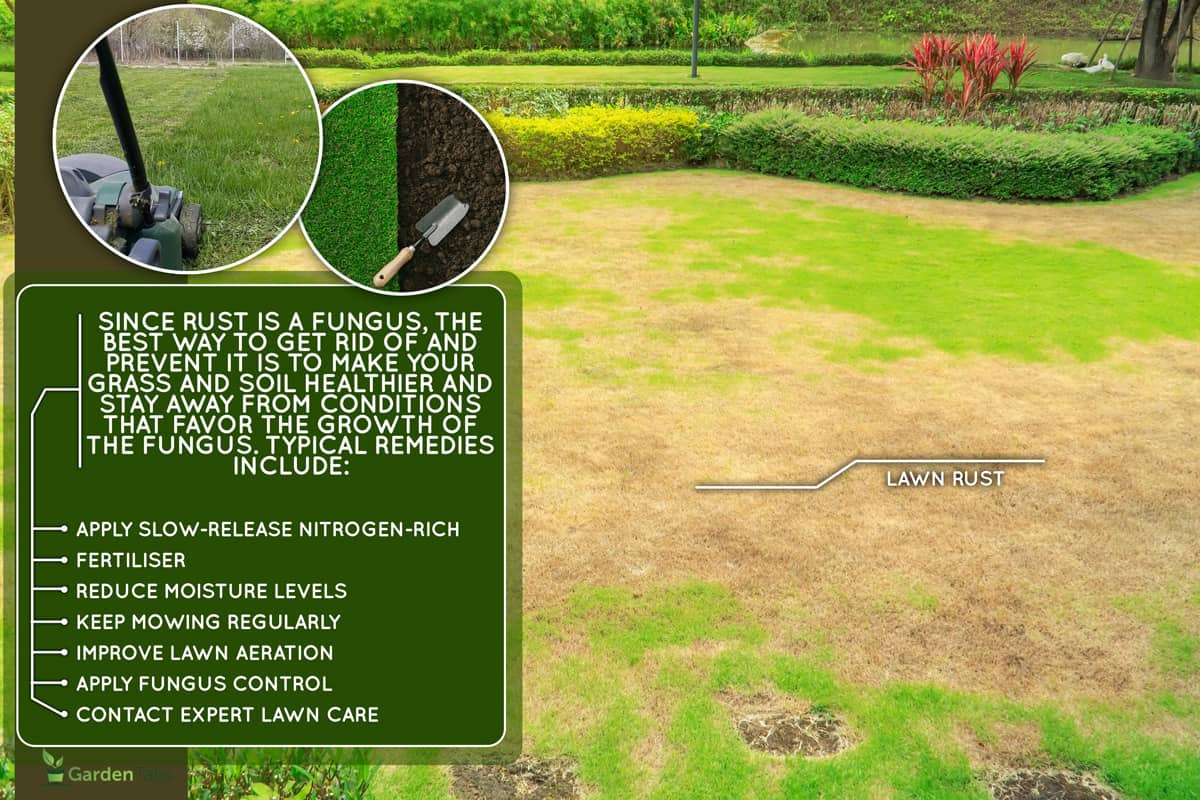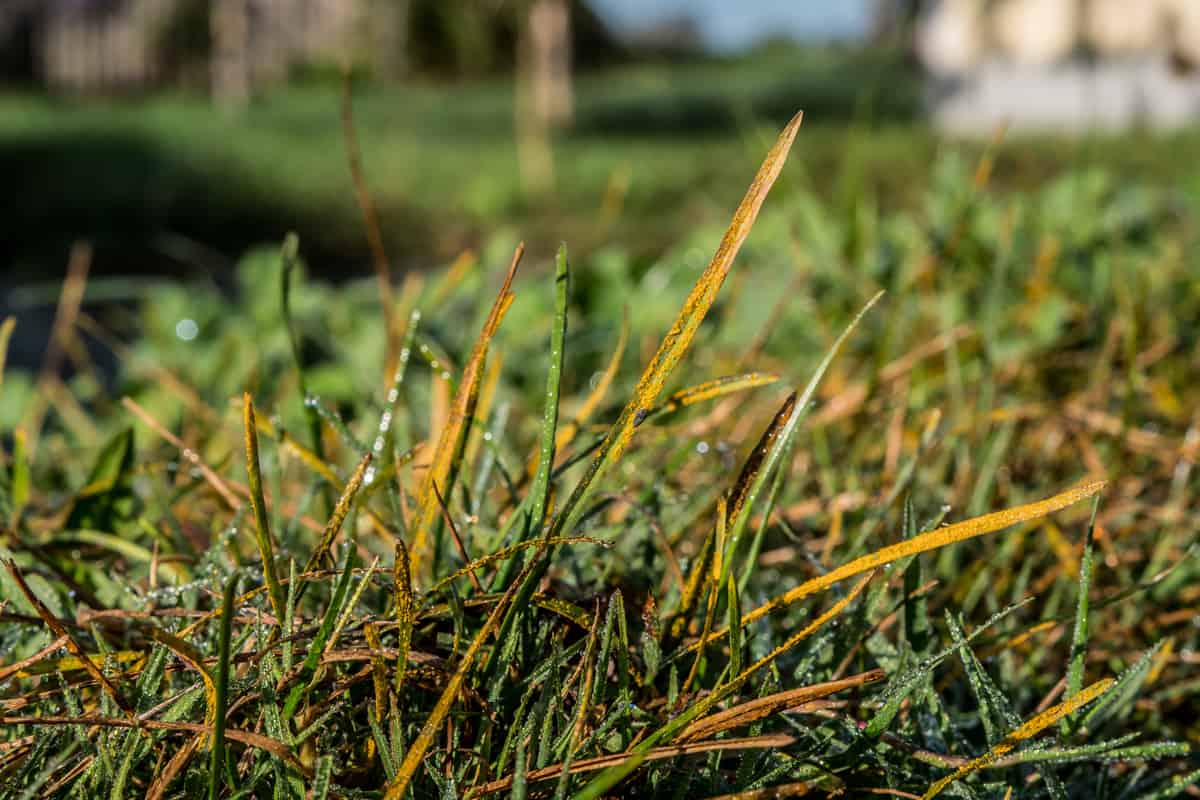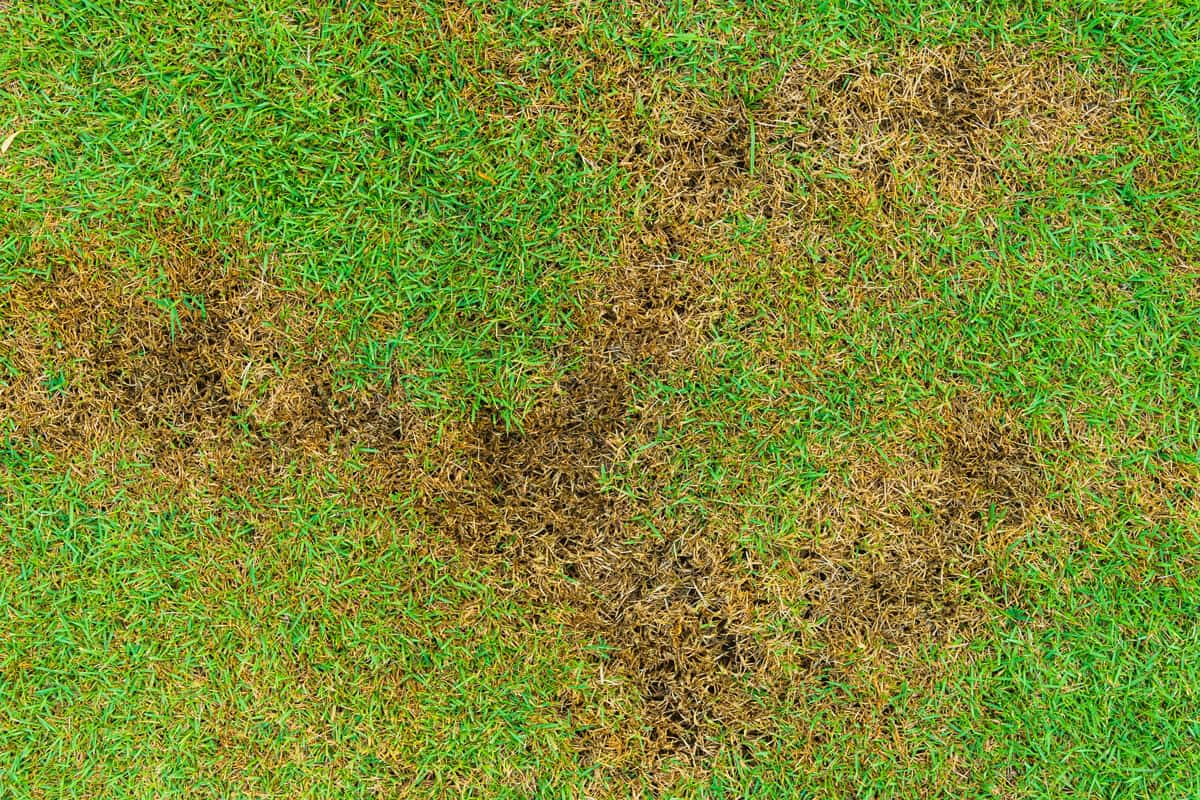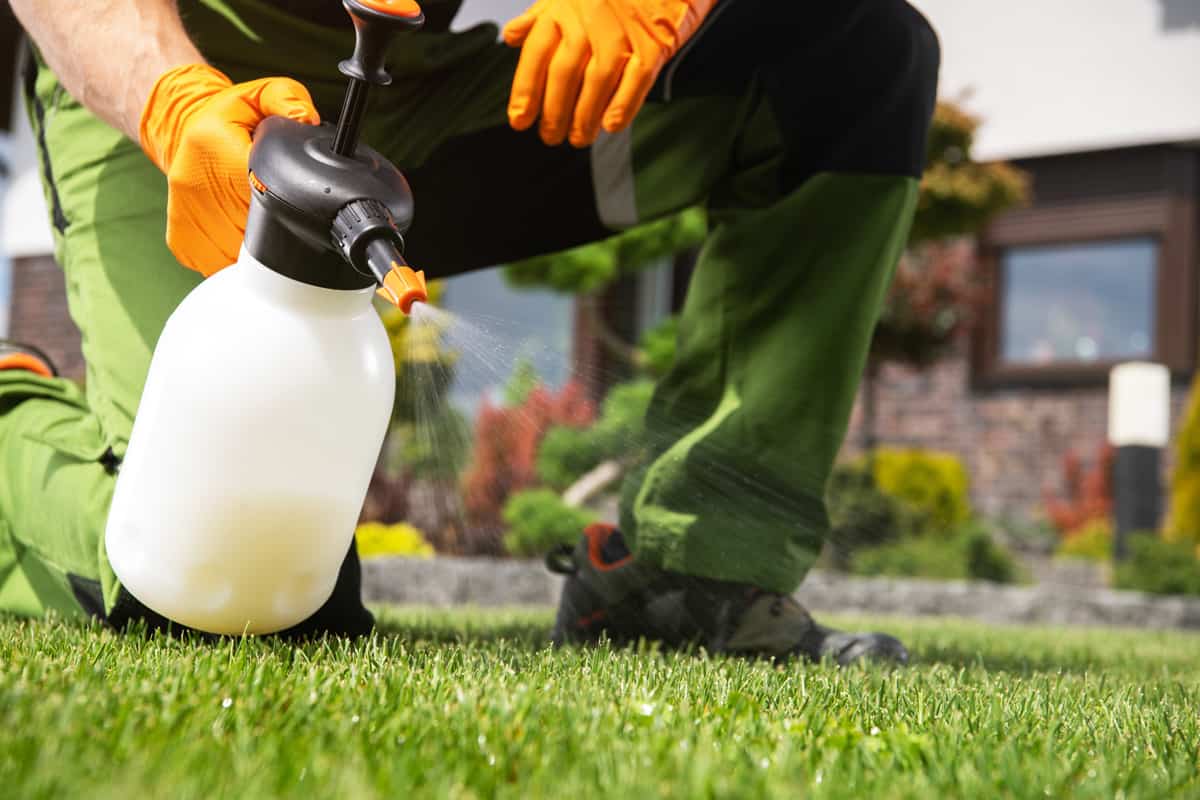It's easy to freak out when you first see a few spots of orange-yellow grass. Even worse, you can mistakenly believe that low water levels are the cause of the issue and hastily overwater your lawn in an effort to solve it. Those spots are what we call lawn rust. Want to get rid of and prevent it properly? Well, we researched this thoroughly and here's what we found.
Lawn rust is a fungus, and the best way to get rid of and prevent it is to make your grass and soil healthier and stay away from conditions that favor the growth of the fungus. Typical remedies include:
- Applying Slow-Release Nitrogen-Rich Fertiliser.
- Reducing Moisture Levels.
- Mowing Regularly.
- Improving Lawn Aeration.
- Applying Fungus Control.
- Contacting Expert Lawn Care.
In this article, we'll discuss why this rust appears on your lawn and then we get into the details of how to treat and prevent lawn rust. Also, we'll share some ideal fungicides in the market. So keep on reading.

Why Does My Grass Have Rust?

Rust is an opportunistic fungus, just like all other fungal diseases. When the environment is hospitable, it thrives, but when it's not, it struggles.
This means that rust is far more prone to occur when your lawn is unhealthy. This is because unhealthy grass is already susceptible to infections and pests. Rust won't have to put up as much of a struggle to take root and spread.
Additionally, excessive watering can foster the growth of rust, especially if there is a lot of moisture present right at the soil's surface and close to the grass. Rust prefers low light levels and minimal air movement.
Even reasonably well-maintained lawns can develop rust if the soil is low in quality, the lawn is overwatered, or it has been too long since your last aeration. Overgrown, overwatered lawns are great real estate for rust.
You might even start to notice bare patches of grass in your yard as the rust spreads and kills off all the grass. The leaves of grass get covered in orange dust and your lawn starts to take on reddish-brown colors.
How To Get Rid Of & Prevent Lawn Rust On Your Home Landscaping?

Acting quickly after spotting rust in your yard might help you avoid more expensive remedies like replacing your turf. The secret is to determine the cause of your rust and attempt to improve grass-friendly conditions while making rust-friendly conditions worse. Fortunately, there are techniques for both treating and preventing it, such as:
Apply Slow-Release Nitrogen-Rich Fertiliser
Apply a high-nitrogen fertilizer to the grass, particularly one with a slow-release formula that will maintain stable nitrogen levels for a longer time. But be careful in the late fall, when cool-season grasses stop growing and warm-season grasses are about to enter their winter dormancy.
You might choose to wait out the winter if the season is later than September or October. The probability is that the fungus will disappear in the cold. Your grass's health will improve and become more resilient to other diseases, such as rust, when you maintain the right level of nutrients in your soil.
Reduce Moisture Levels
When it comes to watering your lawn, there is no one strict guideline. Depending on your climate and soil conditions, different grass cultivars may require a different approach to care.
Usually, you want to lower the moisture levels that are promoting the growth of the fungus. Rust likes moist environments, therefore by watering less frequently, you'll create unfavorable circumstances for this fungus.
Make sure to continue watering for a sufficient amount of time to thoroughly saturate the soil. A healthy lawn should have deep roots, and longer, less frequent watering can aid in the development of those deep roots. Frequent, shallow waterings can lead to too much surface water, which can be an issue.
If you have automated sprinklers, you should immediately switch to manual watering if you discover rust in your lawn. One of the main causes of rust is overwatering.
In general, frequent, shallow irrigation is worse for your grass than deep irrigation done sparingly. Water the lawn as well in the morning so that it can dry out over the day.
You may boost grass health and eliminate one of the most conducive environments for rust by manually watering just when your lawn actually needs moisture rather than on a regular schedule.
Keep Mowing Regularly

Although it may seem paradoxical given that rust likes to disperse spores across your lawn, mowing is a crucial step. Lawn mowing encourages grass thinning. More airflow and sunlight penetration result from this. Both are detrimental to rust fungus. Cutting your lawn allows new grass to grow where the old grass once was.
Additionally, it helps to get rid of diseased and infected grass before the rust spores have a chance to develop and spread. Just be sure you're getting rid of all the cuttings. If not, they'll likely trap moisture and obstruct ventilation, making your rust problems worse.
Improve Lawn Aeration
Your grass is more likely to get rust disease when it is exposed to wet, moist air. Air flow through and around your lawn is essential if you want it to remain dry and free of moisture.
Cutting branches from trees that droop over the grass or trimming the shrubs and hedging around it will help to improve air circulation. More light enters the space in this method, and the sunlight dries out your grass while lowering humidity and eliminating rust.
Apply Fungus Control
If everything else fails, you might want to think about using a chemical fungicide to get rid of the rust. Although these treatments work, they can be harsh on your grass and other plants.
It's better to deal with rust issues without the use of a fungicide, but if your rust problem has gotten out of hand, it might be your best alternative. Only apply treatments to rust-active parts of your lawn. The rest of your lawn can experience more issues than improvements as a result of preventative treatment.
Contact Expert Lawn Care
Although fungicide isn't normally required, consumers frequently can't access the kinds of fungicides that are helpful against grass rust. To have the right product applied to your grass, you must contact an expert.
If you speak with a specialist about lawn rust, they can assist you in developing a fertilization and upkeep schedule that will help your grass become stronger and more naturally resistant to the fungus.
A specialist can not only get rid of fungus from the lawn but also stop it from coming back in the future. Don't allow a fungus to ruin your fun, leave that to the experts.
What Are Some Ideal Fungicides To Kill Lawn Rust?

Since most fungicides include hazardous chemicals, use them to treat lawn rust only after the other four methods have failed. You might take into account the following if you need to use a fungicide to control a very bad outbreak of grass fungus. However, make sure to strictly adhere to the fungicide's instructions if using them.
BioAdvanced Fungus Control
This excellent fungicide penetrates leaves, stems, and grass blades to strengthen them and increase their resistance to/ability to outgrow fungi diseases. This fungicide works well on rust as well as brown patches, red thread, dollar spot, and other fungi.
Simply attach the bottle to the hose to get a strong, precise spray that is naturally diluted with water. This results in quick and simple fungicide action and work.
Click here to see this BioAdvanced fungus control on Amazon.
Propiconazole 14.3
It is one of the most economical and effective systemic fungicides available that can stop and manage several grass diseases such as rust for up to three weeks. Also, it is a fantastic choice for preparing your lawn for winter and avoiding snow mold in the spring at the end of the season.
Click here to see this Propiconazole 14.3 fungicide on Amazon.
Scotts DiseaseEx
It is an all-encompassing systemic fungicide that may rid your lawn of a variety of lawn diseases, including rust fungus. The granular form of this product eliminates the hassle of mixing and attaining the right quantities. All you need to use this fungicidal chemical efficiently is a broadcast spreader or a Wizz spreader.
After being applied, the solution is absorbed by the grass blade. The results become apparent in 24 hours, and your lawn is protected for up to 4 weeks. Remember to water your grass after applying the solution to make sure it is properly absorbed by the blades.
Click here to see this Scotts DiseaseEx fungicide on Amazon.
Scotts GrubEx1
The production of a wide range of pest management chemicals, particularly those that harm lawns, is Scotts' area of expertise. Even if you do not have a fungicide to treat white, yellow, or brown patches, it is still advisable to use this treatment to stop their occurrence.
In fact, the spring or the first few weeks of the summer are when the grass is most sensitive. Therefore, if you use this fungicide on lawns now, it will help you avoid grubs for the following four months.
Click here to see this Scotts GrubEx1 fungicide on Amazon.
Spectracide Immunox
This fungicide can eliminate the fungus that can result in brown patches, black spots, powdery mildew, and other diseases. It is a reasonable option that is suitable for roses, lawns, trees, shrubs, and ornamentals.
Click here to see this Spectracide Immunox multi-purpose fungicide on Amazon.
Final Thoughts
Despite how bad it may appear, a lawn rust infection won't harm the grass permanently and is typically simple to treat. Applying the right fertilizer, watering less, mowing on time, and proper aeration are the most common ways to revive your lawn. Fungicide can also help. If this doesn't work, contact a professional as your last resort.
See the articles below for further information on how to manage your own lawn properly.





